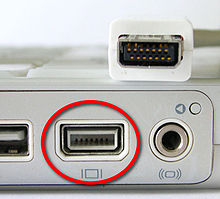| This article needs additional citations for verification. Please help improve this article by adding citations to reliable sources. Unsourced material may be challenged and removed. Find sources: "VGA connector" – news · newspapers · books · scholar · JSTOR (December 2016) (Learn how and when to remove this message) |
 A female DE-15 output in a laptop computer A female DE-15 output in a laptop computer | |||
| Type | Computer analog video connector | ||
|---|---|---|---|
| Production history | |||
| Designer | IBM based on D-subminiature | ||
| Designed | 1987 | ||
| Produced | 1987–present | ||
| Superseded by | DVI (1999) | ||
| General specifications | |||
| Hot pluggable | Depends | ||
| Video signal | RGB video signal plus option H and V sync | ||
| Pins | 15 | ||
| Connector | DE-15 | ||
| Data | |||
| Data signal | I²C data channel for DDC information | ||
| Pinout | |||
 | |||
| A female DE15 socket | |||
| Pin 1 | RED | Red video | |
| Pin 2 | GREEN | Green video | |
| Pin 3 | BLUE | Blue video | |
| Pin 4 | ID2/RES | Reserved since E-DDC, formerly monitor id. bit 2 | |
| Pin 5 | GND | Ground (HSync) | |
| Pin 6 | RED_RTN | Red return | |
| Pin 7 | GREEN_RTN | Green return | |
| Pin 8 | BLUE_RTN | Blue return | |
| Pin 9 | KEY/PWR | +5 V DC (powers EDID EEPROM chip on some monitors), formerly key | |
| Pin 10 | GND | Ground (VSync, DDC) | |
| Pin 11 | ID0/RES | Reserved since E-DDC, formerly monitor id. bit 0 | |
| Pin 12 | ID1/SDA | I²C data since DDC2, formerly monitor id. bit 1 | |
| Pin 13 | HSync | Horizontal sync (or Composite sync) | |
| Pin 14 | VSync | Vertical sync | |
| Pin 15 | ID3/SCL | I²C clock since DDC2, formerly monitor id. bit 3 | |
| The image and table detail the 15-pin VESA DDC2/E-DDC connector; the diagram's pin numbering is that of a female connector functioning as the graphics adapter output. In the male connector, this pin numbering corresponds with the cable's wire-and-solder side. | |||
The Video Graphics Array (VGA) connector is a standard connector used for computer video output. Originating with the 1987 IBM PS/2 and its VGA graphics system, the 15-pin connector went on to become ubiquitous on PCs, as well as many monitors, projectors and HD television sets.
Other connectors have been used to carry VGA-compatible signals, such as mini-VGA or BNC, but "VGA connector" typically refers to this design.
Devices continue to be manufactured with VGA connectors, although newer digital interfaces such as DVI, HDMI and DisplayPort are increasingly displacing VGA, and many modern computers and other devices do not include it.
Physical design
The VGA connector is a three-row, 15-pin D-subminiature connector referred to variously as DE-15, HD-15 or commonly DB-15(HD). DE-15 is the accurate nomenclature under the proprietary D-sub specifications: an "E" size D-sub connector, with 15 pins in three rows.
Predecessor and early variant
The standard 15-pin VGA connector was derived from the earlier DE-9 connector, which used the same "E" D-shell size (hence that connector's misnomer of DB-9 transferred its "DB" part to the new DE-15 connector as well, see above). Though IBM always used DE-15 connectors for their Video Graphics Array hardware, several VGA clone hardware makers initially did not. Instead, some early VGA hardware, both monitors and VGA cards, used a DE-9 connector for VGA, just like what had been in use for MDA, CGA, Hercules, and EGA. This 9-pin variant of the then-emerging de-facto standard 15-pin connector omitted several pins, which was considered acceptable, because the autodetection features supported by those pins only evolved over time, and prior to Windows 95, there was no user expectation of graphics cards and displays being fully plug and play. DE-9 VGA connectors were generally compatible with each other, and adaptors to the DE-15 standard were available. Ultimately all VGA hardware makers switched to standard DE-15 connectors, relegating the early variant to relative obscurity.
Electrical design
All VGA connectors carry analog RGBHV (red, green, blue, horizontal sync, vertical sync) video signals. Modern connectors also include VESA DDC pins, for identifying attached display devices.
In both its modern and original variants, VGA utilizes multiple scan rates, so attached devices such as monitors are multisync by necessity.
The VGA interface includes no affordances for hot swapping, the ability to connect or disconnect the output device during operation, although in practice this can be done and usually does not cause damage to the hardware or other problems. The VESA DDC specification does, however, include a standard for hot-swapping.
PS/2 signaling
In the original IBM VGA implementation, refresh rates were limited to two vertical (60 and 70 Hz) and three horizontal frequencies, all of which were communicated to the monitor using combinations of different polarity H and V sync signals.
Some pins on the connector were also different: pin 9 was keyed by plugging the female connector hole, and four pins carried the monitor ID.
With the implementation of the VESA DDC specification, several of the monitor ID pins were reassigned for use by DDC signaling, and the key pin was replaced with a +5 V DC output per the DDC spec. Devices that comply with the DDC host system standard provide 5 V ± 5%, from 50 mA to 1 A.
PS/55 signaling
The IBM PS/55 Display Adapter redefined pin 9 as "+12V", which signals the monitor to turn on when the system unit is powered on.
EDID
Further information: Display Data Channel and EDIDIn order to advertise display capabilities VESA has introduced a scheme to redefining VGA connector pins 9, 12, and 15 as a serial bus for a Display Data Channel (DDC).
Cable quality
| This section does not cite any sources. Please help improve this section by adding citations to reliable sources. Unsourced material may be challenged and removed. (April 2021) (Learn how and when to remove this message) |

The same VGA cable can be used with a variety of supported VGA resolutions, ranging from 320×400px @70 Hz, or 320×480px @60 Hz (12.6 MHz of signal bandwidth) to 1280×1024px (SXGA) @85 Hz (160 MHz) and up to 2048×1536px (QXGA) @85 Hz (388 MHz).
There are no standards defining the quality required for each resolution, but higher-quality cables typically contain coaxial wiring and insulation that make them thicker.
While shorter VGA cables are less likely to introduce significant signal degradation, good-quality cable should not suffer from signal crosstalk (whereby signals in one wire induce unwanted currents in adjacent wires) even at greater lengths.
Ghosting occurs when impedance mismatches cause signals to be reflected. A correctly impedance matched cable (75 ohm) should prevent this, however, ghosting with long cables may be caused by equipment with incorrect signal termination or by passive cable splitters rather than the cables themselves.
Alternative connectors

Some high-end monitors and video cards used multiple BNC connectors instead of a single standard VGA connector, providing a higher quality connection with less crosstalk by utilising five separate 75 ohm coaxial cables. The use of BNC RGB video cables predates VGA in other markets and industries.
Within a 15-pin connector, the red, green, and blue signals (pins 1, 2, 3) cannot be shielded from each other, so crosstalk is possible within the 15-pin interconnect. BNC prevents crosstalk by maintaining full coaxial shielding through the circular connectors, but the connectors are very large and bulky. The requirement to press and turn the plug shell to disconnect requires access space around each connector to allow grasping of each BNC plug shell. Supplementary signals such as DDC are typically not supported with BNC.

Some laptops and other portable devices in the early to mid-2000s contained a two-row mini-VGA connector that is much smaller than the three-row DE-15 connector, as well as five separate BNC connectors.
Adapters

Various adapters can be purchased to convert VGA to other connector types. One common variety is a DVI to VGA adapter, which is possible because many DVI interfaces also carry VGA-compatible analog signals. Adapting from HDMI or DisplayPort to VGA without an active converter is not possible because those connectors don't output analog signals.
For conversions to and from digital formats like HDMI or Displayport, a scan converter is required. VGA outputs to interfaces with different signaling, more complex converters may be used. Most of them need an external power source to operate and are inherently lossy. However, many modern displays are still made with multiple inputs including VGA, in which case adapters are not necessary.
VGA can also be adapted to SCART in some cases, because the signals are electrically compatible if the correct sync rates are set by the host PC. Many modern graphics adapters can modify their signal in software, including refresh rate, sync length, polarity and number of blank lines. Particular issues include interlace support and the use of the resolution 720×576 in PAL countries. Under these restrictive conditions, a simple circuit to combine the VGA separate synchronization signals into SCART composite sync may suffice.
Extenders
A VGA extender is an electronic device that increases the signal strength from a VGA port, most often from a computer. They are often used in schools, businesses, and homes when multiple monitors are being run off one VGA port, or if the cable between the monitor and the computer will be excessively long (often pictures appear blurry or have minor artifacts if the cable runs too far without an extender). VGA extenders are sometimes called VGA boosters.
See also
- Component video
- Extended display identification data (EDID)
- List of video connectors
- Super Video Graphics Array (SVGA)
References
- Engst, Adam; Pogue, David (23 November 1999). Crossing Platforms – A Macintosh/Windows Phrasebook: A Dictionary for Strangers in a Strange Land. O'Reilly Media. ISBN 978-1-4919-1679-7. Retrieved 16 February 2021.
- ^ "VGA Cables - A Complete Buyers' Guide". RS Components. Retrieved 16 August 2020.
The terminology here is sometimes used rather interchangeably when it comes to labelling various types of VGA cable and can be a little vague. However, the basic or standard VGA connector type will usually be referred to as some variant of the following: DE-15, HD15, VGA plug, SVGA plug, D-Sub 15 or D-Subminiature, or the more generic RGB connector.
- Shah, Agam (31 July 2012). "VGA ports bowing out of home computers, lingering in the workplace". Computerworld. Retrieved 16 August 2020.
- "9 to 15 pin VGA cable pinout and wiring @ old.pinouts.ru". Archived from the original on 19 December 2010.
- VESA DDC/CI Standard Version 1.1. 2004. p. 31.
DDC/CI supports hot plugging, provided the display can detect a disconnection of the video cable
- ^ "Video Subsystem (Type 1)". IBM Personal System/2 Hardware Interface Technical Reference (PDF) (First ed.). IBM. May 1988. pp. 13.99 – 13.100. Archived from the original (PDF) on 14 May 2018. Retrieved 16 February 2021.
- VESA Enhanced Display Data Channel Standard Version 1.1. Video Electronics Standards Association. 24 March 2004. p. 18.
- "Japanese Display Adapters". Ardent Tool of Capitalism. Retrieved 5 February 2023.
- "Understanding EDID - Extended Display Identification Data". Extron. Retrieved 19 May 2022.
- "What is the VGA connector and how to use it". Tyfon Tech. 8 February 2018. Retrieved 26 July 2022.
- "The Nexus: Projects - VGA to SCART Converter". Nexusuk.org. 26 June 2013. Retrieved 21 October 2013.
- "VGA to TV converter page". Epanorama.net. Retrieved 21 October 2013.
- "VGA Extenders". ramsdensquare.ca. Retrieved 24 August 2024.
External links
| Audio and video connectors | |
|---|---|
| Analog audio | |
| Digital audio | |
| Video | |
| Audio and video | |
| Visual charts | |
| General-purpose | |